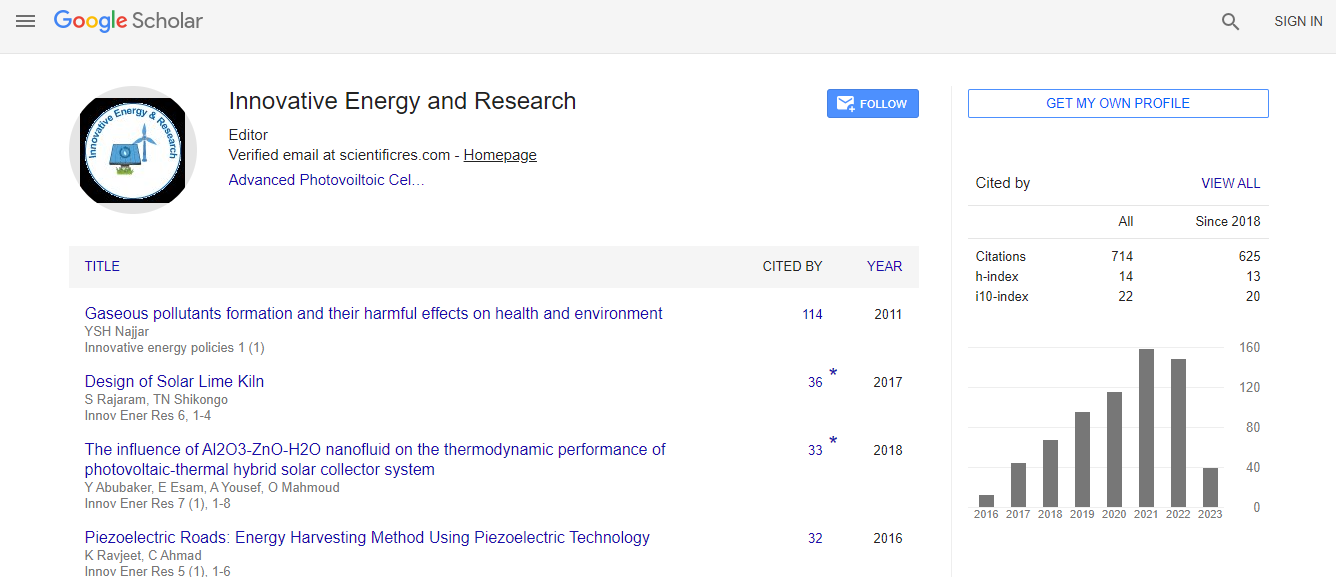Our Group organises 3000+ Global Conferenceseries Events every year across USA, Europe & Asia with support from 1000 more scientific Societies and Publishes 700+ Open Access Journals which contains over 50000 eminent personalities, reputed scientists as editorial board members.
Open Access Journals gaining more Readers and Citations
700 Journals and 15,000,000 Readers Each Journal is getting 25,000+ Readers
Google Scholar citation report
Citations : 712
Innovative Energy & Research received 712 citations as per Google Scholar report
Innovative Energy & Research peer review process verified at publons
Indexed In
- Google Scholar
- Open J Gate
- Genamics JournalSeek
- RefSeek
- Hamdard University
- EBSCO A-Z
- Publons
- Euro Pub
- ICMJE
Useful Links
Recommended Journals
Related Subjects
Share This Page
Adoption of green technology to curb release of greenhouse gases emissions for climate change control in Nigeria: Hydrogen fuel cells technology
Joint Event on 2nd International Conference on Renewable Energy and Resources & Energy Materials and Fuel Cell Research
Olutomisin M Orogbemi
Federal College of Education Obudu, Nigeria
Posters & Accepted Abstracts: Innov Ener Res
Abstract
The awareness of global climate change by emissions of greenhouse gases from fossil fuel combustion is widely known by current society. Polymer Electrolyte Fuel cell (PEFC) technology has been a very promising clean technology with high efficiency that has been used in a wide range of portable, automotive and stationary applications. The fuel cell research has been developing very rapidly and successfully in the last few years. However, some issues remain largely unresolved, namely water management and the high cost of the PEFC component. One of the efficient and cost-effective ways to improve the design of the PEFC and consequently resolve the above-mentioned issues is through modeling. However, the built PEFC models need to be fed with accurate transport coefficients to enhance their productivity. One of the most important transport coefficients is the gas permeability of the PEFC porous media which highly affects the convective flow. Therefore, experimental studies have been conducted to investigate the gas permeability of the gas diffusion media used in PEFCs. The focus has been on the effects of the following on the gas permeability of the gas diffusion layers (GDLs): (i) type of carbon black used in the microporous layers (MPL) attached to the GDL, (ii) carbon and polytetrafluoroethylene (PTFE) loading, and (iii) the thickness of the MPL. Further, a novel method has been proposed to estimate the penetration of the MPL into the carbon substrate (i.e. the GDL before being coated with the MPL ink). Also, the effect of sintering on the gas permeability of the MPL has been investigated for the first time.Biography
E-mail: tomisinigbane@yahoo.com

 Spanish
Spanish  Chinese
Chinese  Russian
Russian  German
German  French
French  Japanese
Japanese  Portuguese
Portuguese  Hindi
Hindi 
